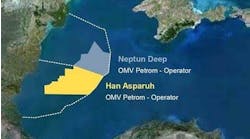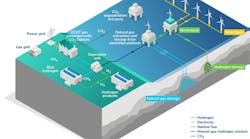EQUIPMENT/ENGINEERING: Network-in-a-box offers real-time link between drilling units, offices
Ilana Zalika
Springboard
A conglomerate of companies designed and implemented a solution to use a satellite system to connect a drilling firm's offshore rigs with onshore offices, providing each with integrated real-time voice and data capabilities at relatively high speed.
Helmerich & Payne needed a way to link 80 land and offshore drilling rigs to all of its facilities across a single central network. Working with the integration consulting group FDDI-AVD and InterSat Communications, Helmerich & Payne (H&P) leveraged solutions from Motorola's Multiservice Networks Division to build and deploy the high-speed satellite and terrestrial-based network.
The process of sharing information between H&P's rig locations, including such locations as the Gulf of Mexico, Argentina, and Wyoming, and the company's corporate headquarters in Tulsa, had previously been a challenge. Many rigs were located offshore, or in remote land locations, with no access to traditional network facilities. Over a short term, H&P used a dial-up network, coupled with cellular phones for voice communications. The solution was piecemeal, limited, and costly, explained Chuck Clark, H&P's Manager of Telecommunications. "Our cellular service alone was costing as much as $3,000 per month per rig."
H&P's solution was satellite-based and provided voice and data connections between all of its rigs, regardless of location, without unnecessary complex installation and maintenance requirements. The solution was designed around the Motorola Vanguarda multi-service network units, which enabled the convergence of data, voice, and video while laying the foundation for wireless/wireline integration. The devices provided on-demand bandwidth to support a broad range of high-speed transmissions. A microwave and/or satellite network deployed on each rig and remote location connected the company's offshore drilling operations in the Gulf of Mexico with the H&P home office in Tulsa. Motorola Vanguard also provided a data encryption and compression feature.
Network-in-a-box
The solution was rolled out for the first 10 sites within two months. Today, all 80 sites are connected to both the home office and each other. To simplify the process of adding new sites to the network, a "network-in-a-box" was developed by combining the routers, satellite, and servers into a single self-contained unit. This provided fast easy replication, deployment, and reduces costs. With Motorola, H&P plans to increase the number of connected sites over the next several years. The network can be scaled to support the exact needs of each office and drilling platform, noted Clark. He added that the flexibility helped speed up business development activities, with more active pursuit of new contracts.
On-site customers share available bandwidth, connecting to their own internal information systems and communicating with colleagues and partners. Real-time drilling data can also be delivered to customers' regional or headquarter offices, providing them with updated information on each day's activities. An additional initiative being considered is to equip rig personnel with PDAs (personal digital assistants or hand-helds) and other devices to capture information faster, and distribute it to customers and contractors in real-time.




